The iPhone 4 Redux: Analyzing Apple's iOS 4.0.1 Signal Fix & Antenna Issue
by Brian Klug & Anand Lal Shimpi on July 15, 2010 12:28 PM EST- Posted in
- Smartphones
- Apple
- iOS 4
- iPhone 4
- Mobile
In case you haven’t noticed, the iPhone 4’s antenna design has come under considerable scrutiny. In our iPhone 4 review, we investigated the iPhone 4 antenna and came to two conclusions. First, that iOS 4 was displaying signal bars in an overly optimistic manner, compressing the dynamic range of possible signal bars users can see. Second, we identified a worst case signal drop of around 24 dB when the iPhone 4 is cupped tightly in the left hand, covering the black strip and possibly detuning the antennas and adding additional attenuation from the presence of the hand.
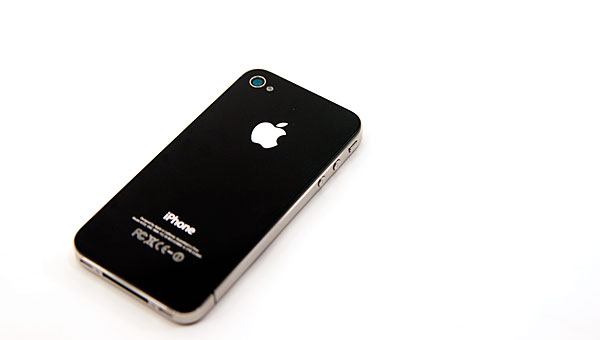
Since those initial measurements, we’ve been working tirelessly to both characterize the problem, fully understand the mechanisms behind it, and report on a number of possible solutions.
The Bars Have Changed
On July 2, Apple released a letter noting that the formula used in iOS 4.0 to calculate how many bars are presented for each signal strength is “totally wrong.” This mirrored our conclusions that the effects of the signal drop were exacerbated in part by the way the iPhone visualizes signal strength - the dynamic range is compressed so much that the 24 dB drop from cupping the phone without a case could make all the bars go away.
They went on to promise that in a future software update they would make bars 1, 2, and 3 taller, and make the bars more “accurate” by displaying 2 bars fewer in certain circumstances.
iOS 4.1 beta rolled around yesterday, and we immediately dove in to find out just how much the bar to signal strength mapping has changed. Update: iOS 4.0.1 final just came out this afternoon and we finished preliminary testing. The signal strength mapping algorithms are identical to the 4.1 beta. The findings in this article apply to 4.0.1 as well as the 4.1 beta.

After updating our devices to the iOS 4.1 beta (and 4.0.1) and making sure our little trick to show signal strength in dBm instead of bars still worked, we set off. Remember last time how I said I drove around town all day with iOS 4.0, testing the phone, and recording signal strength and how many bars were being shown? You guessed it - another update, another evening of driving around. Anand and I did quite our fair share of moving around to get a complete picture of what the new cutoffs are.
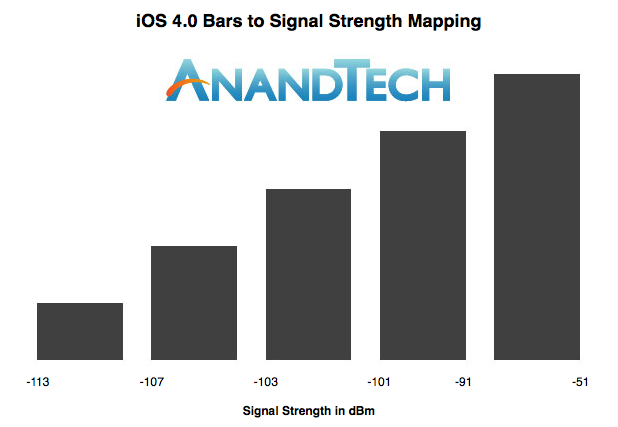
Old Bars
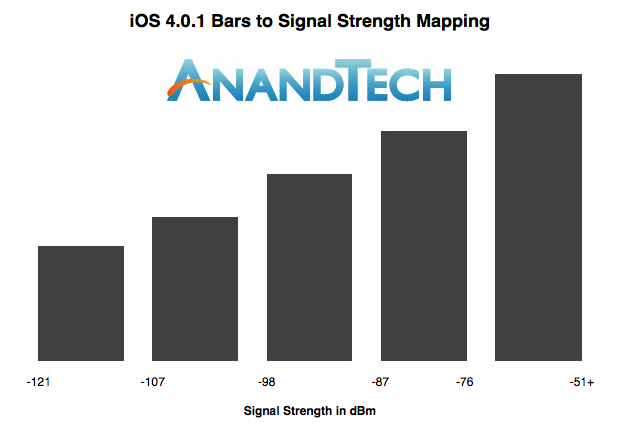
New Bars
The results are conclusive - Apple has dramatically changed the signal strength to signal bar mapping in iOS 4.0.1 and the iOS 4.1 beta, making the dynamic range not only much broader, but the range values for each bar much wider. The range of signals that correspond to bars three and four are the same width, and bar two is only slightly less.
The cutoff value for two bars to one bar remains the same, but every other value has increased. The result is that the worst case drop of 24 dBm no longer makes all the signal bars disappear, but rather two.
AnandTech reader Mike Escoffery, Director of Design and User Experience at Media Platforms, created his own diagram to help compare the old and new way of iOS signal strength reporting:
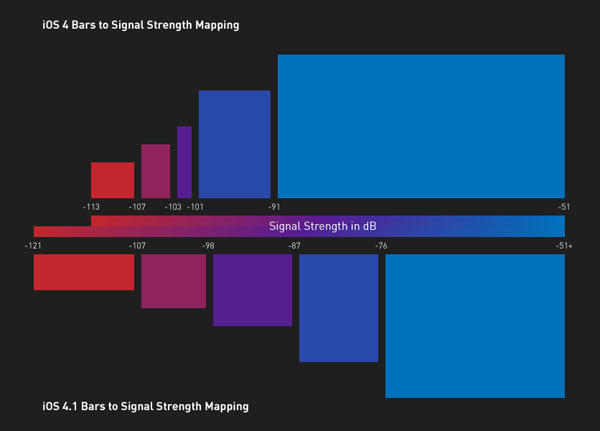
As you can see the old way (top) put far too much weight into the 5th bar of signal. Apple's new approach not only splits it up more reasonably between the 4th and 5th bar (still non-linearly keeping you in the 5th bar if possible) but also extends the range of the lower bars.
This change actually presented itself in our numeric signal strength reports - there’s more dynamic range in these numbers too. Previously, the absolute lowest value any iPhone would report was -113 dBm. With iOS 4.0.1/4.1, the value is now a shockingly low -121 dBm. In the iPhone 4 review, I talked a lot about how although the phone is prone to dropping signal from being held wrong, it was measurably more sensitive in weak signal areas. I was shocked that calls and data worked seemingly unfazed at -113 dBm. It seems as though this increased 8 dBm of range below -113 dBm was meant to show really how much more sensitive the radio stack is - it undeniably is more sensitive. Both Anand and I were able to hang onto calls all the way down at -121 dBm.
We’ve also included a comparison to how the latest version of Android displays signal bars from GSM or UMTS networks below. Thankfully, this didn’t require driving around town all day but rather inspecting the latest version of the Android source code from Google’s own repositories. Android uses an ASU value to compute signal strength, which isn’t anything more than a remapping of dBm to a sane value that’s a bit easier to interpret.
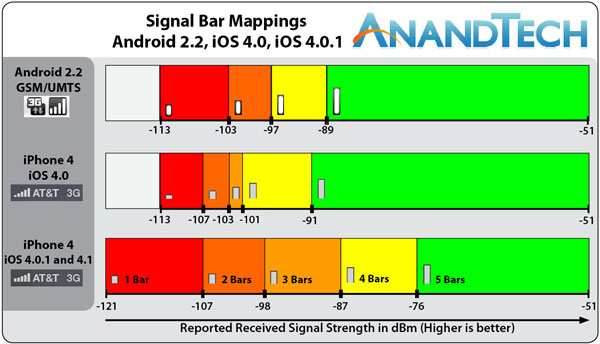
Apple’s mappings have gone from having probably the most compressed dynamic range among handset vendors to less compressed than Android.
While the software update obviously does not and cannot address the design of the antenna itself - or make the drop from holding the phone any less - it does change the way the issue is perceived among users. The result is that most iPhone users will see fewer bars disappear when they hold the iPhone 4 in a bare hand. The side effect is that the iPhone now displays fewer bars in most places, and users that haven’t been reporting signal in dBm will time see the - perhaps a bit shocking - reality of locations previously denoted as having excellent signal.
Interestingly enough, Apple has indeed changed the heights of bars 1, 2, and 3. They’re taller, and the result is that the relative heights are no longer linear, but rather a tad exponential looking. It’s a mind trick that Apple no doubt hopes will make the signal look better. If the bars are taller, they must denote stronger signal, right?
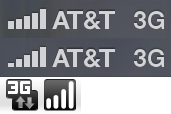
From top to bottom: iOS 4.1, iOS 4.0, Android 2.2
The reality is that Apple likely wants to deflect at least some of the initial backlash AT&T will face for reporting the signal bars without any concessions. Concessions that used to make coverage look better than it really is. Regardless of how tall the bars are, there are still going to be fewer of them virtually everywhere. Interestingly enough, while bars 1 and 2 are the most changed, their respective cutoffs are virtually unchanged.
While I was testing iOS 4.0.1, I told Anand that the signal reporting lie that started with the iPhone 3G had been removed entirely. That iOS 4.0.1 would potentially show the reality of AT&T’s coverage to iPhone users. With 4.0.1 users looking at signal bars will get a much more realistic view of how signal is changing.
We tested the iOS 4.1 beta on iPhone 3GSes as well, and found the mappings to be the same there as well.










146 Comments
View All Comments
mac11 - Friday, July 16, 2010 - link
Glad I had the patience to read thru this long article. It's logical, unbiased, THOROUGH, and grammatical(meakes it more pleasant to read). After reading 1,000 article titles, and over 100 articles referring to the Apple antenna issue / non-issue, I finally come to a rather complete understanding of the matter. I feel at ease now knowing what needs to be known.My conclusion: iPhone 4 antenna has greater extended sensitivities, but more susceptible to interference from hand grips than 3GS or Nexus One. And the call can be dropped due to this deeper interference if your starting signal was weak enough to start with. And the re-formulated signal strength bars gives much more truthful representation of your area signal strength.
Thank you AnadTech.. kudos, and my respecta to your great journalism.
a different user name - Friday, July 16, 2010 - link
How are they showing signal power dB dBm instead of bars on iPhone 4?jmlev - Friday, July 16, 2010 - link
How do I switch from bars to a -db reading on my iPhone4, like you show in the pictures?gypsy1962 - Friday, July 16, 2010 - link
Guys, as usual, 1st class commentary! I highly applaud your technical and analytical skills, a skill-set sorely missing in much of the commentary flowing around the net these days...marraco - Friday, July 16, 2010 - link
The olders bars jus were a hoax to cheat buyers into thinkin than the device got better signal than competing products.Again the same history. Marketing propaganda.
Now also Apply blames the buyer over a design flaw, pretending that the signal is lost because the owner grab the device in wrong way.
This is from a company that pretends to charge high prices for “better” quality.
betanerd - Friday, July 16, 2010 - link
When you referred to the "signal reporting lie that started with the 3g". Are you referring to When it was released people complained about poor signal. Then Apple released an "update" that supposedly fixed it. I remember something of the sort happening. Perhaps the pr/updates have all be to make owners feel better till the next itteration. 3g complaint: bad signal-->update disproportionate(signal readout inflation) bar formula. ip4 complaint: signal drops/bad signal -->update more proportionate bar formula(your signal isn't really that good) + bigger, easy to read, confidence(ala enzyte) inspiring bars. Has/can anyone checked older releases to see if this is the case. If so it may make the argument/lawsuit stronger. Not that I wish any ill will towards Apple.+Some have mentioned a possible problem with they way the micro sims are cut. Where the contacts touch the metal sim tray which touches the metal antenna band. Any truth to that?
+Perhaps placebo effect Have any reports come in about different serial numbers? Such as 8___=death grip susceptible, 7____=not susceptible? from Mac rumors it may have been debunked but, i was from a sample of 1.
+ Have any owners that say they have no problems come forward to have their phones tested or recored the testing by death grip and multimeter?
I'm not sure how much it matters...Free cases till Sept30!
Hxx - Friday, July 16, 2010 - link
apple announced that they will give a free protective casehttp://online.wsj.com/article/SB100014240527487049...
v12v12 - Friday, July 16, 2010 - link
I love it... watching the illogical, the brainwashed and zombified consumer-cattle actually try and defend a company (irregardless of if it's "Apple" or not) that's been factually proven over many, many years to actively and purposefully defraud consumers with falsified and heavily padded performance (G4/5 anyone?) data. Documented and legally proven accounts of advertising and marketing fraud (search it yourself if you're gullible enough to ask) to further profits. Settling many justified lawsuits out of court (Creative for 100MIL?!) as to not have to admit “wrong doing,” or face the laws they’ve broken…__This company is well known (factually documented) for using strong-arm tactics to control vendors AND even their own consumer base... Yes "Apple" tells you it's YOU that has the problem, even if it's them. Blah blah, this isn't a bash, for these shady practices apply to many other competing companies as well.
So here's your insanity; you the consumer-cattle (pleb) are required by law to pay in full, up front for this device. They are required to render to you a FULLY WORKING device for which you paid. You find out that the device is bugged/not working 100% AS ADVERTISED (there's a law for that also) and now you're looking for retribution, but are told "sorry, there's no problem." It's YOUR problem I guess? Mean while what's going on behind the scenes are nothing but meetings on how to keep the "problem" internalized, until they can find a 'solution'..." in the meantime you are left with little recourse to solving this issue until Apple tells you??? Ever tried to return an iPhone, you'd think you were trying to return a bomb from the vehement response from the "geniuses" at the Apple store... So what now, yep just sit there and WAIT for Apple to tell you what or if there's a problem (regardless if Anand/Gadget/someone else proves it) at all... Then more waiting on a "solution," but all the while WHO is reimbursing you for your time, hassle, lack of service, AND interest on your money they now have possession of...
Why is it that as the consumer, you/we have to go through all these hoops, lies, tricks and turmoil over a device that's been PAID FOR IN FULL? Turn the logic around and apply the same habitual shenanigans to consumer behavior, and Apple will send you a court summons to get "their" money asap! Heck they might refuse service to you based on your shoddy track-record. "Oh you say my check/CC didn't clear... sorry it's cleared, there's something wrong with your machines kthxbye..." "What, you want me to send you extra money b/c the 1st installment didn't fully cash out? Sorry I'll get you the money when I get it..." "Oh you want the money right now, and extra for your troubles... yeah umm, I'll let ya know when I get the rest (I still say it's your machines in error), but for now, here's $5 to tide you over..."
Would this bull-shat work if the tables were turned, hell fscking NO it wouldn't work... so who in their right mind expects to get what they've been told they'll get? This crap is just laughable... year after year, product "upgrade" after upgrade; you are still getting hustled by Apple/Vzn/big-business and there's naves out there so fanatical and brainwashed into defending these overt, mega greed based institutions. Lol INSANITY… But there’s relief in knowing no matter how factual, logical, common-sense based your diatribe is, SOME cattle just won’t ever get it. They’ll keep buying, supporting these businesses that want nothing but to rip you off and leave you with whatever you get; “working” or not… Slave mentality to the MAX… lmfao (Though I do wish Anand/Tom etc would stop with the hand slapping and stick these criminals in the FIRE they deserve.)
SunSamurai - Friday, July 16, 2010 - link
blahblahblahblahShow us on the doll where apple touched you.
Levictus - Saturday, July 17, 2010 - link
Do you get paid to defend Apple from criticism or something? Because you seem a little too obsessed with arguing with people who criticize Apple. I mean if you like their products or are into Steve Jobs, good for you. You need to understand that there are people who have other interests in life than Apple's products and marketing.